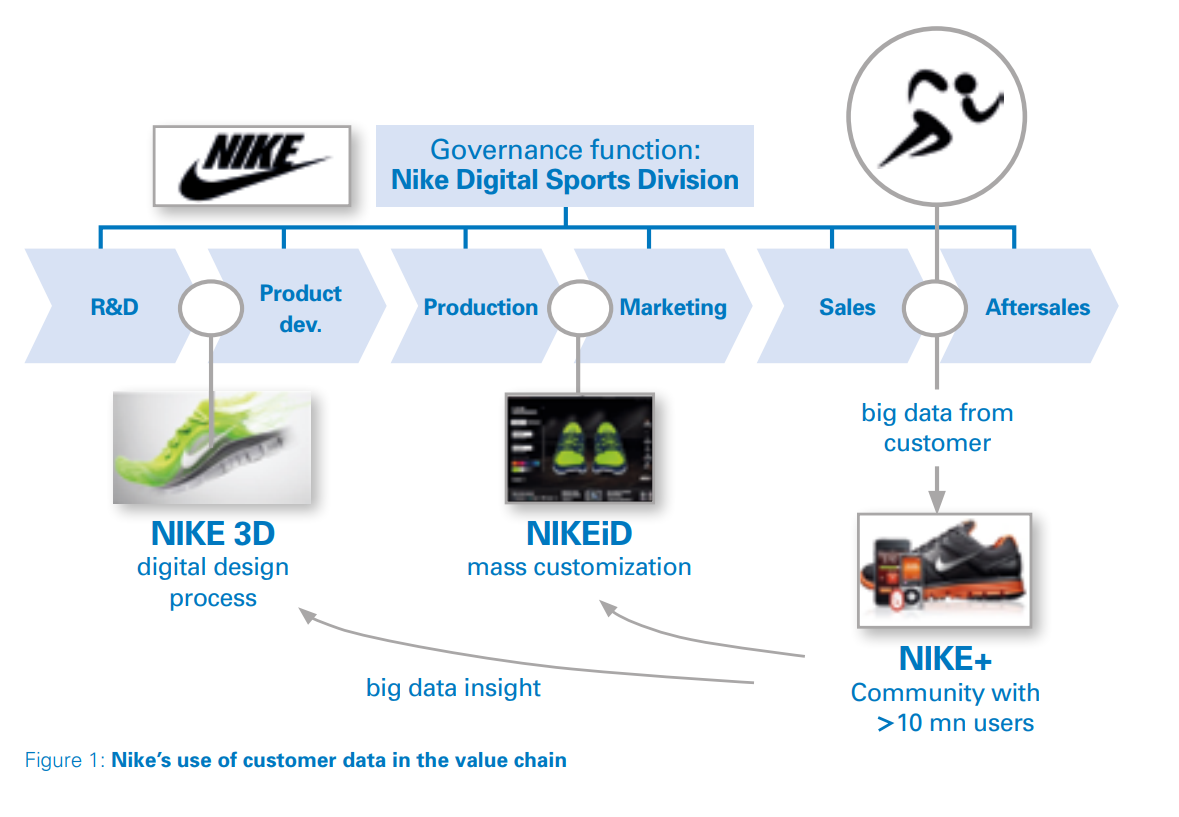DOWNLOAD
3 min read • Strategy, Organization & transformation, Digital Shift
Four key questions to consider for successful digital transformation

The majority of “analog-native” companies are struggling to become digitally mature enough to compete with “digital-native” rivals. How can they adapt strategies, business models, organizational structures and capabilities to remain competitive and relevant? This article focuses on the four key questions analog-native companies need to address if they are to successfully embrace digital transformation.
Digitalization is a cross-societal megatrend, affecting and challenging all sectors, from manufacturing to local government. Consequently, executive interest in digital transformation is increasing rapidly, as more and more organizations face agile disruptors harnessing new technologies to compete against them.
We define digital transformation as: The use of digital technologies and data to create new value propositions and operating models. These are enabled by digital innovation and creativity to address new digital usages, behaviors and needs, rather than enhancing and supporting traditional methods.
There are, however, very few success stories of traditional “analog-native” companies becoming digitally mature enough to compete with “digital-native” players. This is driving an urgent need to adapt strategies, business models, organizational structures and capabilities to remain competitive in the short term and relevant in the long term. To build lasting differentiation and competitive advantage, this adaptation needs to be carried out while, at the same time, preserving, enhancing and expanding the core business. Arthur D. Little has worked with several organizations to successfully accelerate digital transformation. Examples of analog-native companies that are successfully competing with digital-native players include Nike and GE, both of which have launched successful digital divisions that bring in new revenues while enhancing their core business. (See the Nike case example below.)
Currently most companies have yet to get out of the starting blocks, which is demonstrated by the results of “Arthur D. Little’s Digital Transformation Study.” Almost 80% of companies surveyed said that they are still only “digital adaptive” – with their digitalization efforts limited to products and services at best, and with no comprehensive approach to digital transformation. Although many organizations have developed digital strategies, far fewer have managed to implement them successfully. Creating a “sense of urgency” was seen as the top challenge for digital transformation, due to a lack of awareness of the opportunities and threats to businesses. Around 50% of the organizations surveyed considered lack of skills and competencies their major challenges on the digitalization journey.
Case example: The Nike Digital Sports Division
The Nike Digital Sports Division is a digital governance function providing resources, budget and coordination for cross-functional digitization projects across the enterprise. This ensures that the vast amount of data the company has, such as from the NIKE+ community, is used as a strategic asset for marketing and product development.


Nike has a long relationship with Apple, based on developing and providing its suite of Nike+ apps. Through this, Nike has created an ecosystem that gives athletes access to their fitness history, training programs, and favorite gear every time they connect with the company. This converts to potential sales as Nike rolls out direct-to-consumer e-commerce sites globally.
Preferences expressed within the Nike+ community also feed back into the digital design process. Through its work in the 3D printing space, Nike can now make and tweak prototypes in hours, instead of months. The benefits of this approach include a unified consumer experience through big data-based synchronization of the supply chain, and optimization of resource allocation. For example, Nike’s spending on TV and print advertising in the US has dropped by 40% due to the integration of its customers in the business value chain.

3 min read • Strategy, Organization & transformation, Digital Shift
Four key questions to consider for successful digital transformation


The majority of “analog-native” companies are struggling to become digitally mature enough to compete with “digital-native” rivals. How can they adapt strategies, business models, organizational structures and capabilities to remain competitive and relevant? This article focuses on the four key questions analog-native companies need to address if they are to successfully embrace digital transformation.
Digitalization is a cross-societal megatrend, affecting and challenging all sectors, from manufacturing to local government. Consequently, executive interest in digital transformation is increasing rapidly, as more and more organizations face agile disruptors harnessing new technologies to compete against them.
We define digital transformation as: The use of digital technologies and data to create new value propositions and operating models. These are enabled by digital innovation and creativity to address new digital usages, behaviors and needs, rather than enhancing and supporting traditional methods.
There are, however, very few success stories of traditional “analog-native” companies becoming digitally mature enough to compete with “digital-native” players. This is driving an urgent need to adapt strategies, business models, organizational structures and capabilities to remain competitive in the short term and relevant in the long term. To build lasting differentiation and competitive advantage, this adaptation needs to be carried out while, at the same time, preserving, enhancing and expanding the core business. Arthur D. Little has worked with several organizations to successfully accelerate digital transformation. Examples of analog-native companies that are successfully competing with digital-native players include Nike and GE, both of which have launched successful digital divisions that bring in new revenues while enhancing their core business. (See the Nike case example below.)
Currently most companies have yet to get out of the starting blocks, which is demonstrated by the results of “Arthur D. Little’s Digital Transformation Study.” Almost 80% of companies surveyed said that they are still only “digital adaptive” – with their digitalization efforts limited to products and services at best, and with no comprehensive approach to digital transformation. Although many organizations have developed digital strategies, far fewer have managed to implement them successfully. Creating a “sense of urgency” was seen as the top challenge for digital transformation, due to a lack of awareness of the opportunities and threats to businesses. Around 50% of the organizations surveyed considered lack of skills and competencies their major challenges on the digitalization journey.
Case example: The Nike Digital Sports Division
The Nike Digital Sports Division is a digital governance function providing resources, budget and coordination for cross-functional digitization projects across the enterprise. This ensures that the vast amount of data the company has, such as from the NIKE+ community, is used as a strategic asset for marketing and product development.


Nike has a long relationship with Apple, based on developing and providing its suite of Nike+ apps. Through this, Nike has created an ecosystem that gives athletes access to their fitness history, training programs, and favorite gear every time they connect with the company. This converts to potential sales as Nike rolls out direct-to-consumer e-commerce sites globally.
Preferences expressed within the Nike+ community also feed back into the digital design process. Through its work in the 3D printing space, Nike can now make and tweak prototypes in hours, instead of months. The benefits of this approach include a unified consumer experience through big data-based synchronization of the supply chain, and optimization of resource allocation. For example, Nike’s spending on TV and print advertising in the US has dropped by 40% due to the integration of its customers in the business value chain.


